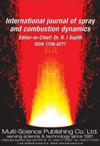用一组简洁常微分方程建立非线性火焰响应模型
IF 2.1
4区 工程技术
Q3 ENGINEERING, MECHANICAL
International Journal of Spray and Combustion Dynamics
Pub Date : 2022-03-01
DOI:10.1177/17568277221094760
引用次数: 2
摘要
在这项工作中,我们提出了一组简约的常微分方程(ODEs),该方程在时域和频域中以令人满意的精度描述了典型层流预混火焰的线性和非线性动力学。所提出的模型具有两个二阶常微分方程的特征,这两个常微分方程可以解释为两个具有对称非线性阻尼项的质量-弹簧-阻尼器耦合振荡器。该非线性项被确定为x 2 x▪之后位移率的函数。该模型只需要校准四个常数。这是通过对从高保真度数值模拟(CFD)获得的一个输入和一个输出宽带信号执行优化程序来实现的。注意,所研究火焰的传递函数(FTF)或描述函数(FDF)不是先验已知的,因此在优化过程中没有使用。一旦该模型在CFD输入和输出时间序列上进行了训练,它就能够定量准确地恢复所研究的层流火焰的脉冲响应,从而恢复相应的频率响应(FTF)。如果输入不同频率和振幅的谐波信号,则训练的模型能够定性精确地检索所研究火焰的火焰描述函数(FDF)。我们证明了非线性项x2 x▪对于捕获输入信号的高振幅的增益饱和是必不可少的。所有结果均根据CFD数据进行了验证。本文章由计算机程序翻译,如有差异,请以英文原文为准。
Nonlinear flame response modelling by a parsimonious set of ordinary differential equations
In this work we present a parsimonious set of ordinary differential equations (ODEs) that describes with satisfactory precision the linear and non-linear dynamics of a typical laminar premixed flame in time and frequency domain. The proposed model is characterized by two ODEs of second-order that can be interpreted as two coupled mass-spring-damper oscillators with a symmetric, nonlinear damping term. This non-linear term is identified as function of the rate of displacement following x 2 x ˙ . The model requires only four constants to be calibrated. This is achieved by carrying out an optimization procedure on one input and one output broadband signal obtained from high-fidelity numerical simulations (CFD). Note that the Transfer Function (FTF) or describing function (FDF) of the flame under investigation are not known a-priori, and therefore not used in the optimization procedure. Once the model is trained on CFD input and output time series, it is capable of recovering with quantitative accuracy the impulse response of the laminar flame under investigation and, hence, the corresponding frequency response (FTF). If fed with harmonic signals of different frequency and amplitude, the trained model is capable of retrieving with qualitative precision the flame describing function (FDF) of the studied flame. We show that the non-linear term x 2 x ˙ is essential for capturing the gain saturation for high amplitudes of the input signal. All results are validated against CFD data.
求助全文
通过发布文献求助,成功后即可免费获取论文全文。
去求助
来源期刊

International Journal of Spray and Combustion Dynamics
THERMODYNAMICS-ENGINEERING, MECHANICAL
CiteScore
2.20
自引率
12.50%
发文量
21
审稿时长
>12 weeks
期刊介绍:
International Journal of Spray and Combustion Dynamics is a peer-reviewed open access journal on fundamental and applied research in combustion and spray dynamics. Fundamental topics include advances in understanding unsteady combustion, combustion instability and noise, flame-acoustic interaction and its active and passive control, duct acoustics...
 求助内容:
求助内容: 应助结果提醒方式:
应助结果提醒方式:


